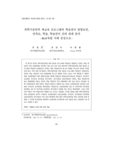

-
 * 본 문서는 배포용으로 복사 및 편집이 불가합니다.
* 본 문서는 배포용으로 복사 및 편집이 불가합니다.
미리보기
서지정보
· 발행기관 : 한국기업교육학회
· 수록지 정보 : 기업교육연구 / 14권 / 2호
· 저자명 : 윤현진, 윤관식, 이병철
목차
Ⅰ. 서 론
Ⅱ. 이론적 배경
Ⅲ. 연구 방법
Ⅳ. 연구결과
Ⅴ. 결론 및 제언초록
본 연구의 목적은 과학기술인력을 위한 재교육 프로그램의 학습전이 영향요인, 만족도, 학습, 학
습전이 간의 상관관계를 실시하여 이들 요인 간의 상호 관련성과 과학기술인력을 위한 재교육 프
로그램의 학습전이 영향요인이 만족도, 학습, 학습전이에 정(+)의 영향을 주는지의 여부를 규명하
는데 있다. 이에 대한 연구결과로 과학기술인력을 위한 재교육 프로그램의 학습전이 영향요인이
만족도, 학습, 학습전이 간의 상관관계와 정(+)의 영향을 미치는 것으로 각각 확인할 수 있었다.
첫째, 상관관계분석 결과 변화가능성을 제외한 학습전이 영향요인(자기효능감, 학습동기, 전이동기,
교육내용, 강사능력, 전이설계, 상사지원Ⅰ, 상사지원Ⅱ, 동료지원)들은 만족도, 학습, 학습전이와
높은 상관관계를 보였고, 만족도, 학습, 학습전이 간의 상관관계도 매우 높은 것으로 나타났다. 둘
째, 다중회귀분석 결과 만족도, 학습에 공통으로 영향을 주는 요인은 교육훈련설계 요인들인 교육
내용, 강사능력, 전이설계로 확인되었고, 학습전이는 교육훈련설계 요인 중 강사능력과 전이설계,
업무환경 요인 중 상사지원Ⅰ(간접적인 상사지원)이 영향을 주는 것으로 확인되었다. 그리고 만족
도와 학습이 각각 학습전이에 영향을 주는 것으로 나타났다. 이러한 결론을 통해 과학기술인력을
위한 교육훈련에 있어서 무엇보다 교육훈련설계 요인(교육내용, 강사능력, 전이설계)과 업무환경
요인(간접적인 상사지원)이 의미 있게 해석됨에 따라 향후 과학기술인력을 위한 교육과정 설계 및
개발 시 이러한 연구결과를 반영하여 교육훈련을 실시한다면 보다 실효성 있는 교육훈련이 될 것
으로 기대할 수 있다.영어초록
The purpose of this research are to identify the relationships between factors influencing transfer of
learning, trainees’ satisfaction, learning, and transfer of learning in R&D human resources training and to
examine the influences of the factors on satisfaction, learning, and transfer of learning. ‘
The main results of this study are as follows:
First, as a result of the correlation analysis, factors influencing learning transfer other than ‘possibility
of change’ (self-efficacy, learning motivation, transfer motivation, training content, trainer’s competency,
transfer design, supervisor’s support I, supervisor’s support Ⅱ and colleague’s support) showed high
correlations with satisfaction, learning, and transfer of learning. Possibility of change also showed
correlations with satisfaction and learning at the 95% significance level, but showed little correlation with
transfer of learning.
Second, the regression analysis showed that training design factors such as training content, trainer’s
capabilities and transfer design influenced both satisfaction and leaning, and that transfer of learning was
influenced by trainer’s capabilities, transfer design, and supervisor’s support I (indirect support). Moreover,
it showed that satisfaction and learning had influences on transfer of learning.
It is expected that if R&D training programs are designed and developed using the results of this
study, the programs will be more effective.참고자료
· 없음태그
-
자료후기
Ai 리뷰이 자료는 깊이 있는 설명과 다양한 예시 덕분에 과제를 작성하는 데 큰 도움이 되었습니다. 앞으로도 이런 유익한 자료가 계속 등록되기를 바랍니다! -
자주묻는질문의 답변을 확인해 주세요

꼭 알아주세요
-
본 학술논문은 (주)학지사와 각 학회간에 저작권계약이 체결된 것으로 AgentSoft가 제공 하고 있습니다.
본 저작물을 불법적으로 이용시는 법적인 제재가 가해질 수 있습니다. -
해피캠퍼스는 구매자와 판매자 모두가 만족하는 서비스가 되도록 노력하고 있으며, 아래의 4가지 자료환불 조건을 꼭 확인해주시기 바랍니다.
파일오류 중복자료 저작권 없음 설명과 실제 내용 불일치 파일의 다운로드가 제대로 되지 않거나 파일형식에 맞는 프로그램으로 정상 작동하지 않는 경우 다른 자료와 70% 이상 내용이 일치하는 경우 (중복임을 확인할 수 있는 근거 필요함) 인터넷의 다른 사이트, 연구기관, 학교, 서적 등의 자료를 도용한 경우 자료의 설명과 실제 자료의 내용이 일치하지 않는 경우
“기업교육연구”의 다른 논문도 확인해 보세요!
-
중소기업 중간관리자의 앙트러프러너십(entrepreneursdhip) 역량 증진 프로그램 설계 30 페이지
본 연구는 기업의 운영과 발전에 중추적 역할을 담당하는 중간관리자들의 앙트러프러너십 역량 증진 프로그램을 설계함에 목적을 두고 있다. 이러한 연구목적 달성을 위해 우선 문헌 및 사례분석, 심층면접을 통해서 중간관리자를 대상으로 앙트러프러너십 역량의 하위요소를 도출하였고, 핵심가치 추출 및 구현을 위해 프로그램 모형의 핵심 프로세스와 프로세스 지원 요.. -
공무원 국외교육프로그램 연수에서 학습만족도가 직무 효능감 및 직무 몰입 변화를 매개로 교육훈련전이에 미치는 영향 16 페이지
본 연구는 공무원 교육, 특히 공무원 국외교육프로그램 연수에 대한 학습만족도가 궁극적 인 업무성과로 이어지게 하는 교육훈련전이에 영향을 끼치는 지를 확인함에 있어 직무 효능 감과 직무 몰입 각각의 연수 전 · 후의 변화를 분석하였다. 연구대상은 국내 지방자치단체 중 하나인 A도청에서 국외교육프로그램 연수를 다녀온 공무원 80명이었다. 연구결과에 따르면.. -
국내 기업 적용을 위한 감성역량의 정의 및 구성요인 탐색 30 페이지
최근 경영혁신 분야의 기업 경쟁력으로 다양성, 창의성 그리고 감성경영이 주목을 받고 있다. 그러나 해외 선행연구를 기반으로 감성역량에 관한 국내연구들은 리더의 역할 및 역량에 대한 논 의수준을 높여 주었으나, 국내 기업에 적용 가능한 감성역량의 개념과 구성요인들을 구체적으로 분석하지 못하는 한계점을 보이고 있다. 본 연구에서는 국내 감성 및 역량 관련.. -
중소기업의 학습조직 평가 및 전략과 학습조직화 사업 참여 특성 28 페이지
중소기업 대상의 학습조직화 사업은 기업이 학습조직화 사업을 시작하도록 유도하며 이들 이 몇 년에 걸쳐서 활발하게 참여할 때에 조직 내의 학습이 활발하게 될 것이라고 전제한다. 본 연구는 정부주도의 학습조직화 사업에 참여하는 중소기업의 학습조직 수준 및 선호하는 지원전략에 대한 인식을 조사하였다. 그리고 이 인식들과 사업 참여와 관련된 속성들과의 관 .. -
해외주재원 파견교육 및 조직지원이 현지적응 및 경력몰입에 미치는 영향 : 국내 건설사를 중심으로 24 페이지
최근 국내 건설사의 해외진출이 활발해지면서 건설사의 해외주재원이 증가하고 있으나 해외건설근무 자의 파견교육 및 조직지원의 구체적인 성과와 영향에 대한 연구는 부족한 상황이다. 이에 본 연구는 해 외건설근무자의 파견교육 및 조직지원이 파견 후 어떠한 성과를 나타내는지를 실증적으로 검증하고자 하였다. 해외주재원의 경우 파견 후 가장 우선시되는 성과는 현지..
문서 초안을 생성해주는 EasyAI

